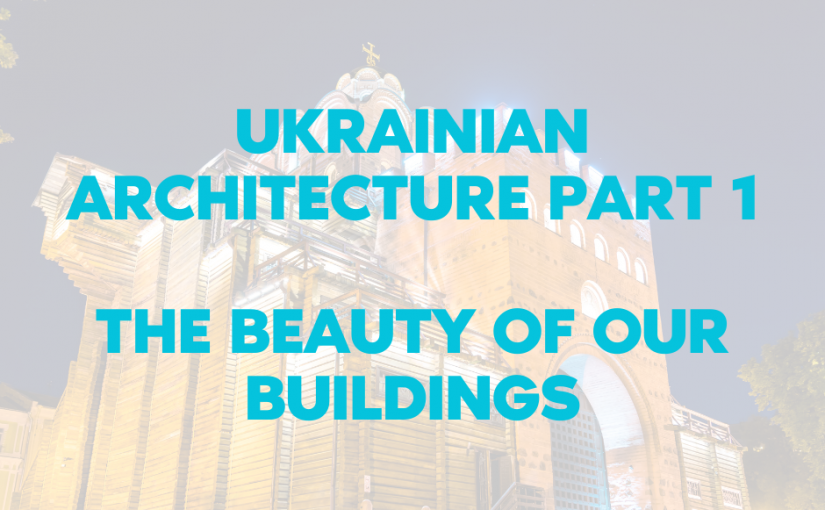
The Beauty of Our Buildings
Ukrainian architecture is diverse and fascinating. It combines different styles and traditions, the day’s fashion, and local flair.
Kyivan Rus style

Reconstruction of the original Saint Sofia Cathedral in Kyiv 1037 – 1054
The Byzantine style influenced the architecture of Kyivan Rus, but Rus quickly developed its unique way. The best examples of this architecture can be found in Kyiv, Chernihiv, and Novhotod.
Churches, fortifications, and palaces at this period were made out of wood. The first stone church was built in Kyiv in the 10th century. The Byzantine domes were reformed. Inside the churches, there were colours, mosaics, and frescoes.

The Golden Gate in Kyiv, largely reconstructed, 1100
Ukrainian Baroque

Kyiv-Pechersk Lavra
Ukrainian Baroque took its roots from Western European Baroque. It existed in the 17-18th century and is also called Cossack Baroque.
The characteristics of Ukrainian Baroque are:
dominating role buildings have in comparison with the landscape; the isolation of inner space from the environment; the strict hierarchical structure of buildings; and the tendency for standardized planning and building.
This period was marked by developing planning, volumetric, and spatial structures of buildings of different functional types: inhabitable, public, defensive, or industrial.

Church of St Elias in Subotiv
In the 18th – 20th century, the Russian Empire influenced the Ukrainian Baroque style; thus Russian architects such as Bartolomeo Rastrelli implemented their projects in Ukraine.
For example, Mariinskyi Palace is a very bright example of this work.

Mariinskyi Palace, 1752, late Baroque style
Ukrainian Classicism
Classicism came to Ukraine in the second half of the 18th century. This style presents classical Greek and Roman cultures, simplicity, and severity.
This style first appeared in Western Ukraine and then spread all over the country.

Kachanivka palace (18th century)

An entrance to the Sofiivka park in Uman, 1802
Gothic and neo-gothic churches
Pointed arches and ribbed vaults supported by vertical shafts and buttresses are the characteristics of the gothic style. It served mainly as a transitory style in Western Ukraine, where most Gothic churches, fortresses, and castles are.

Khotyn castle in Kamianets-Podilskyi, 1250-1340

Church in Stryi, Lviv region, 1425

Church of St. Olha and Elizabeth, Lviv, 1911, neo-Gothic style
This neo-gothic building is the highest church in Lviv (85 meters) and the most popular tourist attraction in Lviv.
Art Nouveau in Ukraine
Art Nouveau style is inspired by nature, characterized by sinuous, sculptural, and organic shapes, often including arches, curving lines, and sensual ornamentation. Common motifs include stylized leaves, flowers, vines, insects, animals, and other natural elements.
This style produced quite a bit of innovation within the shaping, decor, and ornamentation of buildings.

House with Chimaeras, 1902
Since Horodecki was an avid hunter, the building derives its popular name from the ornate decorations depicting exotic animals and hunting scenes sculpted by Italian architect Emilio Sala.

Lviv Railway Station, 1904
Lviv Railway Station is one of the most notable pieces of Art Nouveau architecture in former Galicia (Halychyna).
Moorish Revival architecture
In the 19th century, Ukrainian architects drew inspiration from the exotic “Moorish” style.
The Moorish architecture has unique characteristics: pointed arches, called “ogees”, horseshoe arches, intricately detailed tile mosaic and patterned brickwork; onion domes, lobed arches, and window tracery.

Odessa’s Philharmonic Theatre, 1894
The design of the theatre resembles the Doge’s Palace in Venice.

Uzhhorod Synagogue, 1904
The building was designed in a striking Romantic style that boldly intermingled Byzantine and Moorish Revival architectural elements.
Folk architecture
Skilled carpenters and masons, as well as ordinary peasants, created folk architecture. Usually, folk architecture was present in the villages but also in towns and homesteads.
Unfired clay mixed with cut straw was the primary building material in the steppe regions of Ukraine, with wood used only for the ceiling, roof, door, and window frames.

Houses in the forest-steppe area were made of a timber frame with woven willow branch walls.
Clay was used to coating the dwellings afterwards bleached with lime.

Wooden houses were widespread in western and northern Ukraine.
Posts or long timbers were used to construct the walls. After that, spikes were typically hammered into the walls to prepare them for plastering.
According to statistics of 1924, wood (posts or logs) made up 50% of surveyed houses in the Ukrainian SSR, clay made up 33%, and stone and brick made up the rest.
That was Part 1 of the article about Ukrainian architecture. What styles also exist in your country? Share in the comments.
Next time we’ll tell you about soviet and contemporary architecture in Ukraine. Don’t miss it!



